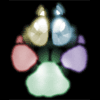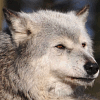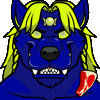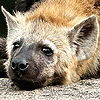
Is it?
Is it not?
Twenty four carot?
One carrot?
Is it edible?
Is it not?
Mmmm. Smells good.
***crunchcrunchcrunch***
Moar!!!
Is it not?
Twenty four carot?
One carrot?
Is it edible?
Is it not?
Mmmm. Smells good.
***crunchcrunchcrunch***
Moar!!!
Category Photography / Animal related (non-anthro)
Species Cervine (Other)
Size 1087 x 839px
File Size 1.01 MB
Musk Ox, Poco, from Helsinki Zoo. See the battle in the thread above to find out that Musk Ox are misnamed and are not oxen, but a kind of SuperGoat ™ ... but they look like an ox, act like an ox and poop like an ox.
In fact, I'd go so far as to say they are oxactly like oxen. :)
In fact, I'd go so far as to say they are oxactly like oxen. :)
In the trendy textiles circles, this beast is called Qiviot, and its downy undercoat is much sought-after to handspin into yarns. A single ounce (28 grams) of Qiviot down sells for $26 USD. It's incredibly soft and ridiculously insulating. Knitters & handweavers tend to use Quiviot yarn sparingly, in lace patterns, both to cut down on the cost and because very little of it is needed to make a warm garment.
Well, the entire pelt isn't as valuable as the down/undercoat of fur. Guard hair is coarse and unusable except for making bristle brushes, rope, and very hard-wearing yarn for rugs. The skin can be stretched raw over the frame of a drum, or it can be tanned into leather. Qiviot down is collected by hand from the open tundra, as the animals shed during the summer months. In its raw state, th fibre is full of lichens, moss and other vegetable debris that must all be picked out by hand. This labour-intensive process is partly what makes Qiviot fibre so expensive. You can't exactly approach a wild ox and expect to shear it like a domesticated sheep or goat without it running away from you, trampling you, or goring you, so you wait for the damn thing to shed and pick up whatever falls off of it. Bison down is similar in most ways, except it's not as soft. The fibre collection process is also different, as it comes from semi-domesticated animals who have been (yes, past tense) raised for their meat. After the animals have been slaughtered for trendy steaks and meat products, someone shears the carcass for its hair, and then the separation process of guard hair from down takes place.. the resulting down fibre sells for approx. $20 USD, which is only marginally cheaper than Quiviot. Personally, I find Bison down easier to spin, because it behaves more like wool.
My spinning blog is very out of date, and needs a full year of updating.... http://spin.mothx3.com/ It's also kind of crappy, but whatever. I've been doing a lot of interesting things with yarn lately, but there's no written or photographic record of these acts, so nobody would know unless they caught me in the act...
Here are five photos of some of my earlier spinning:
http://www.furaffinity.net/full/918752/
http://www.furaffinity.net/full/918783/
http://www.furaffinity.net/full/1179818/
http://www.furaffinity.net/full/1179881/
http://www.furaffinity.net/full/1179893/
Here are five photos of some of my earlier spinning:
http://www.furaffinity.net/full/918752/
http://www.furaffinity.net/full/918783/
http://www.furaffinity.net/full/1179818/
http://www.furaffinity.net/full/1179881/
http://www.furaffinity.net/full/1179893/

 FA+
FA+















Comments